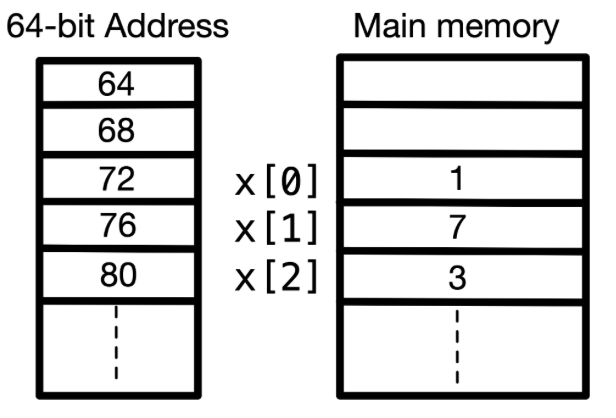Array is representation of a linear list in which elements are stored in contiguous memory locations. Each element can be accessed directly using its index.
An array is stored in contiguous memory locations. This means that all elements of the array are stored one after the other in a single block of memory.
Yes. All elements in an array must be of the same data type, such as integers, floats, or strings, so that the block size is equal. This uniformity allows for efficient memory allocation and access, because the address of each element can be calculated directly using its index.
The time complexities of common operations in an array are as follows (
- Structural operations:
- Initialise an array with initial values:
- Destroy an array:
- Clear an array:
- Check if the array is empty:
- Get the length of the array:
- Initialise an array with initial values:
- Element access operations:
- Get an element by its index:
- Search for an element by its value:
- Traverse all elements with a specific operation on each element (such as printing):
- Get an element by its index:
- Element modification operations:
- Update the value of an element by its index:
- Insert a new element at a specific index:
- Append an element to the end of the list:
- Prepend an element to the beginning of the list:
- Append an element to the end of the list:
- Delete an element from a specific index:
- Delete the last element of the list:
- Delete the first element of the list:
- Delete the last element of the list:
- Update the value of an element by its index:
- Sorting the elements:
Since arrays are stored in contiguous memory locations, the address of any element can be calculated directly using its index. In the following example, if we want to access x[2], we can calculate its address by

Through the address calculation, we can directly access or update the element in constant time, resulting in a time complexity of
To search for an element in an array, we may need to check each element one by one until we find the target element or reach the end of the array. In the worst case, this requires checking all
Inserting or deleting an element at a specific index in an array may require shifting elements to maintain the contiguous memory layout. In the worst case, this may involve shifting all
When creating an array, its memory is pre-allocated. The size of the array must be specified at the time of creation so that a fully empty block of contiguous memory can be allocated. The array cannot grow beyond this size.
There is a more flexible storage representation for linear list called dynamic array. It allows the array to grow and shrink in size as needed. Please refer to my article about dynamic array for details.
Pros:
- Fast access: Arrays allow for constant-time access to elements using their index, making them efficient for read operations.
- Memory efficiency: Arrays have a low memory overhead since they do not require additional pointers or metadata for each element.
Cons:
- Fixed size: The size of an array must be defined at the time of creation and cannot be changed later. This can lead to wasted memory if the array is not fully utilized or insufficient memory if the array needs to grow.
- Expensive insertions and deletions: Inserting or deleting elements in an array can be costly, as it may require shifting elements to maintain the contiguous memory layout.
C has built-in support for arrays.
The array type in C is an implementation of the data structure array:
- Structural operations:
- Initialise a linear list with initial values:
int a[5] = {1, 2, 3, 4, 5}; - Destroy an array: not needed, as arrays are automatically deallocated when they go out of scope.
- Clear an array:
memset(a, 0, sizeof(a));(need to include<string.h>header) - Check if the array is empty: not applicable, as arrays have a fixed size.
- Get the length of the array:
sizeof(a) / sizeof(a[0]);
- Initialise a linear list with initial values:
- Element access operations:
- Get an element :
a[i]gives the - Search for an element by its value: not built-in, need to implement by yourself.
int search(int arr[], int size, int target) {
for (int i = 0; i < size; i++) {
if (arr[i] == target) {
return i; // Return the index if found
}
}
return -1; // Return -1 if not found
}- Traverse all elements with a specific operation on each element (such as printing):
void traverse(int arr[], int size) {
for (int i = 0; i < size; i++) {
printf("%d ", arr[i]);
}
printf("\n");
}- Element modification operations:
- Update:
a[i] = value;updates thevalue. - Insert: not built-in, need to implement by yourself.
void insert(int arr[], int *size, int index, int value) { for (int i = *size; i > index; i--) { arr[i] = arr[i - 1]; // Shift elements to the right } arr[index] = value; // Insert the new element (*size)++; // Increase the size }- Delete: not built-in, need to implement by yourself.
void delete(int arr[], int *size, int index) { for (int i = index; i < *size - 1; i++) { arr[i] = arr[i + 1]; // Shift elements to the left } (*size)--; // Decrease the size } - Update:
- Sorting: not built-in, need to implement by yourself or use library functions like
qsort()from<stdlib.h>header.
There is no built-in array type in Python that behaves exactly like arrays. The list type in Python is an advanced generic container that can be used as an linear list. List operations include all linear list operations, but they may not have the same time complexity as the array because the implementation is different.